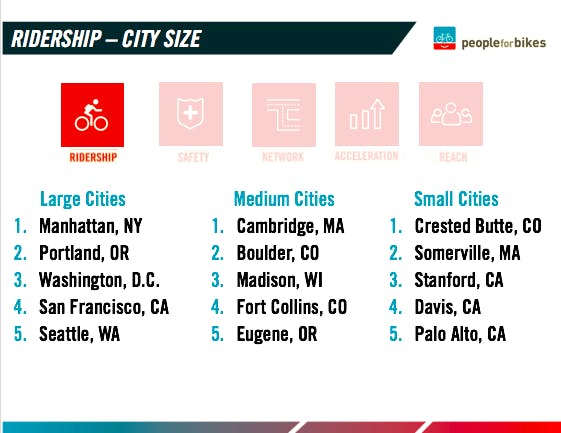2019 Highest Rates of Riding
By: PeopleForBikes Staff

Ridership is linked to a safe bike network
Because our City Ratings scoring system looks at both recreational riding and utilitarian riding, we know that scoring well in Ridership is about creating great places for a variety of biking options. While transportation is the first thing that usually comes to mind when people think about bike infrastructure, a city can’t score exceptionally well in our system if their recreation score is low. Our top cities of various sizes have proven that the way to get more people riding bikes is by investing in a complete bike network and great recreation.
Our method for measuring ridership is unique in that it doesn’t penalize cities like New York or Boston for having lots of transit or foot commuting. Instead of measuring bike commuters as a share of all commuters, it compares bike commuters to the number of car commuters. The method also doesn’t penalize cities like Indianapolis or Tucson for having far-flung city limits that happen to include suburban-style neighborhoods. Despite the fact that some say bicycle mode share is down, cities with an established record of bicycling remain our top performers.

Manhattan tops the list (population 1,588,859)
For 2019, Manhattan, New York wins Ridership by a landslide, scoring at least 0.5 above all other cities. With more protected bike lanes popping up, and dramatic growth in bikeshare, Manhattan has seen ridership increase across the board.
NYC Transportation Commissioner Polly Trottenberg says, “Over the last few years, the City has been transformed, creating major new bike lanes where none previously thought possible – including protected lanes across midtown Manhattan. DOT staff have also helped expand bikeshare, to all the City’s boroughs, which has also helped contribute to an unprecedented citywide growth. Best of all, we have seen cyclist injuries and fatalities decline, as we have seen that more cyclists and bikes – combined with safer bike connections – appears to create a ‘safety in numbers’ effect.”
Cambridge, Massachusetts, top medium-sized city (population 110,696)
Cambridge, Massachusetts recently became the first U.S. city to pass a “Cycling Safe Ordinance,” which requires city streets to be upgraded with the safest option for bike infrastructure whenever a road is reconstructed. Mayor Marc McGovern said in a statement, “With the Cycling Safety Ordinance, the Council codifies a lasting commitment to the users of our roadways that Cambridge intends to have a modern, safe, and accessible network of separated bicycle lanes for all residents regardless of their age or ability.” We know that protected bike lanes and a more complete network lead to more people riding bikes.
The Cambridge Bicycle plan — developed in 2015 — includes a School Wellness Policy, which promotes “physical activity and active transportation to and from school for Cambridge Public School students.” The plan also includes goals for business partnerships and ways to create a healthier community and environment by using bikes.
Crested Butte, Colorado, top small city (population 1,846)
While this mountain town at nearly 9,000 feet is known for its mountain biking, several low-stress streets make it a comfortable place to navigate beyond recreation. Crested Butte is a good example of how great recreation options can transform a community into a safer place to live.
According to David Ochs, Executive Director of Crested Butte Mountain Bike Association, “the need to park the car and get on a bike is almost a rite of passage upon arrival in Crested Butte.” Ochs says travel by bike is the easiest and most enjoyable option. “Surrounded by glorious mountains and climbs in every direction, the town of Crested Butte itself is flat, and the inspiring backdrop just allows more reason to enjoy it via pedal power.”
Ochs says that overall, Crested Butte promotes a slow pace. “With bridges over creeks running though town, sidewalks and ‘safe walks’ for kids to get to school safely, and bikes leaned up against every house and in every rack, one can’t help but want to jump on a bike and make the rounds.”
Recommendations for linking ridership with a network:
- Build bike lanes that connect people to parks, schools, businesses, etc.
- Bike parks are great ways to increase recreational riding, especially for communities without access to natural areas.
- Focus on bikeways that slow vehicle speeds and separate bikes from cars as much as possible.
- Hold a monthly social ride for new bikers. Choose flat, quiet routes and travel slowly.
- Integrate bike riding skills and safety training into elementary school curriculums.
- Incentivize bike commuting with bike-to-work days & weeks. Guide employers to think about showers, parking.
Related Topics:
Related Locations:
